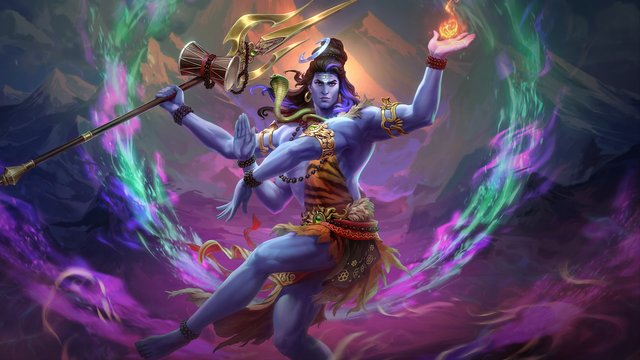
Lord Shiva, often referred to simply as "Shiva," is a major deity in Hinduism and is regarded as one of the principal gods in the Hindu pantheon. He holds a complex and multifaceted role, embodying both destructive and creative qualities. Here are some key aspects of Lord Shiva:
Role and Attributes: Shiva is often depicted as a meditating ascetic, seated in deep meditation or in a yogic posture. He is known as the "Destroyer" within the Hindu Trinity, which also includes Brahma, the "Creator," and Vishnu, the "Preserver." Shiva's destructive aspect is not negative but is seen as a necessary part of the cosmic cycle of creation, preservation, and dissolution.
Auspiciousness and Symbolism: Despite his destructive aspect, Shiva is also known as "Auspicious One" and is associated with transformation and regeneration. He is often depicted with a third eye on his forehead, representing spiritual insight and wisdom. He wears a serpent around his neck, symbolizing his power over death and his mastery of the life force (kundalini energy).
Deity of Meditation and Yoga: Shiva is considered the ultimate yogi and the embodiment of meditation. His deep meditation is believed to maintain the balance of the universe. He is often depicted sitting in a state of deep contemplation on Mount Kailash, his abode.
Family and Consort: Shiva is often portrayed with his consort Parvati (also known as Shakti or Devi). They have two sons, Ganesha and Kartikeya (also called Skanda). Ganesha, the elephant-headed deity, is one of the most widely worshipped gods in Hinduism.
Iconography: Shiva is often depicted with ash smeared on his body, signifying his detachment from material possessions. He is also depicted with a trident (trishul), which symbolizes the three aspects of creation, preservation, and destruction. His blue throat is a result of consuming the poison that emerged during the churning of the ocean (Samudra Manthan) to save the universe.
Worship and Festivals: Shiva is worshipped in various forms across India and beyond. The Maha Shivaratri festival is one of the most significant celebrations dedicated to Lord Shiva. It falls on the 13th night and 14th day of the lunar month of Phalguna (usually in February or March). Devotees fast, meditate, and offer prayers to Shiva during this time.
Shiva Purana and Mythology: The "Shiva Purana" is one of the ancient texts that contains myths, stories, and teachings related to Lord Shiva. It narrates his birth, marriage to Parvati, and various adventures and exploits.
Shiva's worship is deeply ingrained in Hindu culture, philosophy, and spirituality. His multifaceted nature reflects the intricacies of existence, and his stories inspire devotees to seek inner transformation, self-realization, and a connection with the divine.
Lord Shiva, often simply referred to as "Shiva," is one of the principal deities in Hinduism. He holds a central and revered position in the pantheon of Hindu gods. Shiva is known for his multifaceted nature, symbolizing destruction, transformation, and regeneration, as well as being associated with asceticism, meditation, and divine consciousness.
Here are some key aspects of Lord Shiva:
Role in the Trinity: In Hinduism, there is a concept of the divine Trinity, known as the Trimurti. Lord Shiva is one of the three primary deities of the Trimurti, along with Brahma (the creator) and Vishnu (the preserver). Shiva is often depicted as the destroyer who paves the way for new creation and transformation.
Nataraja - Lord of Dance: One of the iconic representations of Shiva is as Nataraja, the Lord of Dance. In this form, Shiva is shown dancing within a circle of flames, symbolizing the cosmic cycles of creation, preservation, and destruction. The dance also represents the rhythm of life and the universe.
Ashes and Third Eye: Shiva is often depicted with a third eye on his forehead, which represents his inner vision, knowledge, and consciousness. He is also associated with wearing ashes (vibhuti) on his body, symbolizing his role in the cycle of life, death, and rebirth.
Meditation and Asceticism: Shiva is a symbol of meditation, introspection, and asceticism. He is often depicted absorbed in deep meditation, sitting in a yogic posture on Mount Kailash, a sacred mountain in the Himalayas.
Trident and Snake: Shiva is often depicted holding a trident (trishula), which represents his control over the three aspects of creation, preservation, and destruction. He is also shown wearing a snake around his neck, which symbolizes his power over the most dangerous creatures and his mastery over fear.
Family and Consort: Shiva is married to the goddess Parvati (also known as Uma or Shakti). Their union represents the balance of masculine and feminine energies in the universe. They have two sons, Ganesha and Kartikeya (Murugan).
Worship and Devotion: Shiva is worshipped by millions of Hindus across the world. His devotees follow various paths of devotion, including meditation, rituals, and offerings. Maha Shivaratri is a major festival dedicated to Lord Shiva, observed with fasting, prayer, and meditation.
Symbolism: Shiva's attributes and symbols, such as the crescent moon on his head, the Ganga (Ganges River) flowing from his hair, and his blue throat (due to drinking the poison during the churning of the ocean), hold deep spiritual and mythological significance.
Shiva's complex and multifaceted nature makes him a deeply revered and meditated-upon deity in Hinduism. He is often seen as both the destroyer of ignorance and the harbinger of spiritual enlightenment.